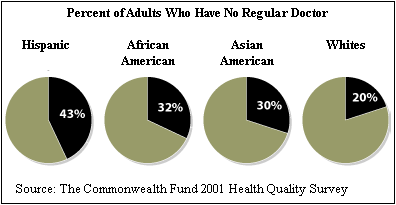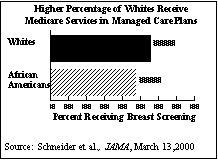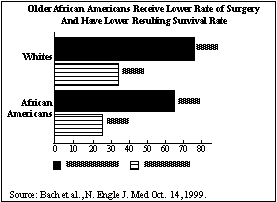|
11.
|
||||||||||||||||||||||||||||||||||||||||||||||||||||||||||||||||||||||||||||||||||||||||||||||||||||||||||||||||||||||||||||||||||||||||||||||||||||||||||||||||||||||||||||||||||||||||||||||||||||||||||||||||||||||||||||||||||||||||||||||||||||||||||||||||||||||||||||||||||||||||||||||||||||||||||||||||||||||||||||||||||||||||||||||||||||||||||||||||||||||||||||||||||||||||||||||||||||||||||||||||||||||
|
Cancer affects people of all racial and
ethnic groups. An estimated 556,500 Americans are expected to die of the
disease in 2003.
However, a close look at cancer rates for racial and ethnic groups
reveals some significant differences. Such differences have been described
as health disparities. A National Institutes of Health working group
defined health disparities as differences in the incidence, prevalence,
mortality, and burden of cancer and related adverse health conditions that
exist among specific population groups in the United States. These
population groups may be characterized by gender, age, ethnicity,
education, income, social class, disability, geographic location, sexual
orientation. One important example of a health disparity is African-Americans’
higher overall cancer incidence and mortality (death) rates compared to
those of other groups. Additionally, certain racial/ethnic groups
experience higher rates for specific cancers than other groups. Many of the differences in cancer incidence and mortality rates among
racial and ethnic groups may be due to factors associated with social
class rather than ethnicity. Socioeconomic status (SES) in particular
appears to play a major role in the differences in cancer incidence and
mortality rates, risk factors, and screening prevalence among racial and
ethnic minorities. Moreover, studies have found that SES, more than race,
predicts the likelihood of a group’s access to education, certain
occupations, and health insurance, as well as income level and living
conditions, all of which are associated with a person’s chance of
developing and surviving cancer. One purpose of this fact sheet is to give a brief overview of the currently available data on cancer health disparities among racial and ethnic groups. The rates are based on statistics from the National Cancer Institute (NCI) and the National Center for Health Statistics. It should be noted that these agencies are concerned that the small size of some non-white population groups and the methods used to collect data have the potential to yield counts that are unrepresentative of the group as a whole. Work to overcome these problems is ongoing. v Cancer Rates The following U.S. incidence and death rates are for all cancers combined. • Cancer Incidence Rates (Number of new cases each year). Statistics are for 1996-2000, are adjusted to the 2000 U.S. standard million population, and represent the number of new cases of invasive cancer per year per 100,000 of both sexes, males, and females, respectively.
• Cancer Death Rates (Number of deaths each year). Statistics are for 1996-2000, are adjusted to the 2000 U.S. standard million population, and represent the number of deaths per year per 100,000 of both sexes, males, and females, respectively.
African -Americans African-Americans have the highest incidence and death rates overall, as well as the highest rates for certain cancers. • African-American Females: Highest incidence rates for certain cancers. Among females, African-Americans have the highest incidence rates of certain cancers, such as colon and rectal cancer and lung and bronchus cancer. Rates are also available for whites, Asian/Pacific Islanders, Hispanics/Latinas, and American Indian/Alaska Natives for these and other cancer sites. Statistics are for 1996-2000, are adjusted to the 2000 U.S. standard million population, and represent the number of new cases of invasive cancer per year per 100,000 females.
• African-American Females: Highest death rates for breast cancer. African-American females experience higher death rates from breast cancer than any other racial or ethnic group, even though whites experience higher incidence rates. Statistics are for 1996-2000, are adjusted to the 2000 U.S. standard million population, and represent the number of deaths or new cases of invasive cancer, respectively, per year per 100,000 females.
• African-American Males: Highest incidence rates for certain cancers. Statistics are for 1996-2000, are adjusted to the 2000 U.S. standard million population, and represent the number of new cases of invasive cancer per year per 100,000 males.
• African-American Males: Highest death rates for certain cancers. Statistics are for 1996-2000, are adjusted to the 2000 U.S. standard million population, and represent the number of deaths per year per 100,000 males.
Hispanics/Latinos While Hispanics/Latinos have lower incidence and death rates overall compared with those of African-Americans and whites, they do experience higher rates for certain cancers. • Hispanic/Latina Females: Highest incidence rates for cervical cancer. Statistics are for 1996-2000, are adjusted to the 2000 U.S. standard million population, and represent the number of new cases of invasive cancer per year per 100,000 females.
• Hispanic/Latina Females: Cervical cancer death rates. Despite high incidence rates, Hispanic/Latina females have the second highest death rate for cervical cancer; African-American females have the highest. Statistics are for 1996-2000, are adjusted to the 2000 U.S. standard million population, and represent the number of deaths per year per 100,000 females.
• Hispanic/Latino Males: Incidence rates for prostate cancer. Hispanic/Latino males have the third highest incidence rate for prostate cancer after African-Americans and whites. Statistics are for 1996-2000, are adjusted to the 2000 U.S. standard million population, and represent the number of new cases of invasive cancer per year per 100,000 males.
• Hispanic/Latino Males: Death rates for prostate cancer. Death rates for Hispanic/Latino males reveal that they have the third highest death rates from prostate and colon and rectal cancer, after African-Americans and whites. Statistics are for 1996-2000, are adjusted to the 2000 U.S. standard million population, and represent the number of deaths per year per 100,000 males.
While Asian/Pacific Islanders experience lower rates overall compared with other minority groups, they do experience higher death and incidence rates for certain cancers. Asian/Pacific Islanders are not a homogenous population and contain subgroups that have different cancer rates. • Highest incidence rates of liver and stomach cancer for both sexes. This group experiences the highest incidence rates of liver cancer and stomach cancer. The liver cancer incidence rate for American Indian/Alaska Natives is much lower. Statistics are for 1996-2000, are adjusted to the 2000 U.S. standard million. Asian Pacific Islanders While Asian/Pacific Islanders experience lower rates overall compared with other minority groups, they do experience higher death and incidence rates for certain cancers. Asian/Pacific Islanders are not a homogenous population and contain subgroups that have different cancer rates. • Highest incidence rates of liver and stomach cancer for both sexes. This group experiences the highest incidence rates of liver cancer and stomach cancer. The liver cancer incidence rate for American Indian/Alaska Natives is much lower. Statistics are for 1996-2000, are adjusted to the 2000 U.S. standard million population, and represent the number of new cases of invasive cancer per year per 100,000 population.
• Asian/Pacific Islander females: Third highest breast cancer incidence rate. Statistics are for 1996-2000, are adjusted to the 2000 U.S. standard million population, and represent the number of new cases of invasive cancer per year per 100,000 females.
• Asian/Pacific Islander females: Third highest incidence for lung and bronchus and colon and rectum cancers. Statistics are for 1996-2000, are adjusted to the 2000 U.S. standard million population, and represent the number of new cases of invasive cancer per year per 100,000 females.
• Asian/Pacific Islander females: Lower death rates for some cancers. Among females, Asian/Pacific Islanders experience the lowest breast cancer and are colon and rectal cancer death rates. Statistics are for 1996-2000, are adjusted to the 2000 U.S. standard million population, and represent the number of deaths per year per 100,000 females.
• Asian/Pacific Islander males: Third in incidence rates for certain cancers. Asian/Pacific Islander males have the third highest rate for lung and bronchus cancer and low colon and rectal cancer. Statistics are for 1996-2000, are adjusted to the 2000 U.S. standard million population and represent the number of new cases of invasive cancer per year per 100,000 males.
• Asian/Pacific Islander males: High death rates for some cancers. Asian/Pacific Islander males experience high death rates for liver cancer and stomach cancer. Statistics are for 1996-2000, are adjusted to the 2000 U.S. standard million population and represent the number of new cases of invasive cancer per year per 100,000 males.
• Asian/Pacific Islanders: Low death rates overall. Statistics are for 1996-2000, are adjusted to the 2000 U.S. standard million population, and represent the number of deaths per year per 100,000 population.
American Indian/Alaska Natives While American Indian/Alaska Natives experience some of the lowest rates among all groups, they do experience higher death and incidence rates for certain cancers. The Indian Health Service reports a large variability in cancer rates among this population, especially in areas such as the Northern plains and Alaska. • American Indian/Alaska Native males: Lowest prostate cancer incidence rates. American Indian/Alaska Native males have the lowest prostate cancer incidence rates. Statistics are for 1996-2000, are adjusted to the 2000 U.S. standard million population, and represent the number of new cases of invasive cancer or deaths, respectively, per year per 100,000 males.
• American Indian/Alaska Native females: Lowest breast cancer incidence rates. American Indian/Alaska Native females have the lowest breast cancer incidence rates. Statistics are for 1996-2000 and are adjusted to the 2000 U.S. standard million population and represent the number of new cases of invasive cancer or deaths, respectively, per year per 100,000 females.
• American Indian/Alaska Native females: Third highest lung and bronchus death rates. However, among females, American Indian/Alaska Natives have the third highest rate of death from lung and bronchus cancer, after whites and African-Americans. Statistics are for 1996-2000, are adjusted to the 2000 U.S. standard million population, and represent the number of deaths per year per 100,000 females.
v What Are Cancer Health Disparities? Disparities in cancer health come from a wide variety of sources. Here are just some examples. Financial sources of disparities include individuals who have no insurance or who are underinsured, those who lack financial resources to cover treatment for disease and who resist financially devastating the rest of the family by drawing on resources, and those who face the complicated array of government financial programs that by conflicting requirements make it extremely difficult to obtain assistance. "Some patients, even those with insurance, find that uncovered financial costs for items such as transportation, child care and medical supplies can rapidly drain family resources causing some patients to sell assets including the family home, farm, or other business, or to go without care." - Voices of a Broken System: Real People, Real Problems, (p.14). Minorities Are More Likely Not to Have a Regular Doctor Quality care comes from a doctor that knows you, but not everyone has a regular doctor. According to the Commonwealth 2001 Health Quality Survey, close to half of all Hispanics in this country do not have a regular doctor (43%). Similarly, nearly a third of all African American (32%) and a third of all Asians Americans (30%) do not have a regular doctor. By contrast, only 20% of white Americans do not have a regular doctor. Minorities Face Greater Difficulty in Communicating With Physicians The percentages of individuals who feel that they have problems communicating with the doctor vary along cultural lines. Such problems include not understanding the doctor, feeling that the doctor did not listen, and having questions but not asking them. According to the Commonwealth 2001 Health Quality Survey, one third of all Hispanics in this country report having difficulty communicating with their doctors (33%). Similarly, nearly a quarter of all African American (23%) and a quarter of all Asians Americans (27%) report having difficulty communicating with their doctors. By contract, only 16% of white
Americans report having difficulty communicating with their doctors. It’s interesting to note that these percentages are similar to the percentages of people who do not have a regular doctor. Transportation Can Limit Access Many individuals lack physical access to cancer treatment because of the lack of appropriate transportation to treatment, because they live in rural areas and what is available is too expensive (tolls, distance, or need for air or boat), or is limited by weather factors, or because the patient is too sick to use the buses and walking options that are available. "Some patients may have to travel up to 300 miles one way for screening or treatment. Some patients may be too ill, either from the disease or the treatment, to make such long trips. Travel and distance are especially a problem for Native Americans living on reservations who may travel long distances to an Indian Health Service facility and wait all day, only to be told to return the next day." - Voices of a Broken System: Real People, Real Problems, (p. 19). Accurate Information is Not Universally Available Many individuals lack appropriate cancer information because health care providers don’t always have reliable and current information and/or skills. Sometimes information is not readily available and usable by patients because of their isolation from resources; literacy, language, and cultural barriers prevent understanding. Patients often need help from an advocate in finding and evaluating information on treatment and in navigating the health care system. In addition, there are not enough surveillance programs, so patients lack an early diagnosis.
Available Information Does Not Reach All Populations "In the United States, African American males experience cancer approximately 15 percent more frequently than white men, and have the highest overall incidence of cancer among all racial groups… However, it is noteworthy that the incidence of lung cancer in 1992 among white men in Kentucky (111 per 100,000) was almost the same as that reported for African American men. In Appalachian Kentucky, a region characterized by high poverty, the incidence of lung cancer among white males in 1992 was 127 per 100,000." - The Unequal Burden of Cancer (p 52). Potential Biases Can Affect Cancer Health Disparities exist for patients with cultural biases whether from cultures where discomfort and pain are tolerated; where the problems of having or treating a disease would be such a problem for the family that a potential disease will be ignored as long as possible; where culturally appropriate treatment is different from available medical treatment (i.e., physicians from the same culture or same gender are not available); and where cancer is still regarded fatalistically. "Until relatively recently, discussing cancer was a taboo in mainstream America. People spoke in hushed tones about "the big C" and cancer patients typically were said to have died "after a long illness." Prohibitions on......disclosing cancer remain strong in many cultures. For example, many Native Americans believe that speaking aloud about cancer will bring it upon the reservation......Latina and African American women may hide their cancer because they fear rejection by their partners. In some Asian cultures, there is a strong fear of being shunned by both family and community......Taken together, these varied cultural beliefs create a ‘code of silence’ that prohibits discussion of cancer, the result of which is delayed care or lack of care, needless suffering, personal isolation, and in many cases, preventable death." - Voices of a Broken System: Real People, Real Problems, (p. 36). Not Everyone Receives the Screening Equally For example, a 2000 study showed that 70.9% of the white women in Medicare in Managed Care Plans received breast screening while only 62.9% of African American women did.
For patients aged 65 or older who had a diagnosis of respectable non-small-cell lung cancer, Stage I or II, 76.7% of the white patients had surgery while only 64.0% of the African Americans did. Five-year survival rates were likewise disproportionate with 34.1% of the whites surviving and 26.4% of the African Americans surviving.
|
||||||||||||||||||||||||||||||||||||||||||||||||||||||||||||||||||||||||||||||||||||||||||||||||||||||||||||||||||||||||||||||||||||||||||||||||||||||||||||||||||||||||||||||||||||||||||||||||||||||||||||||||||||||||||||||||||||||||||||||||||||||||||||||||||||||||||||||||||||||||||||||||||||||||||||||||||||||||||||||||||||||||||||||||||||||||||||||||||||||||||||||||||||||||||||||||||||||||||||||||||||||


